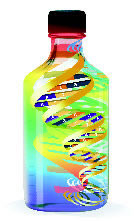The FBI’s national DNA database, the Combined DNA Index System (CODIS) Program, stores DNA profiles. Leads from DNA evidence can be generated from CODIS’ Convicted Offender Index and the Forensic Index. CODIS also contains an Arrestee Index of DNA profiles of people arrested in states where local law allows the collection of samples.
Despite continuing debates about collecting DNA from arrestees, the U.S. federal government and 28 states have laws that authorize arrestee DNA collection. In their June 2012 NIJ Journal article, “Collecting DNA from Arrestees: Implementation Lessons,” Julie Samuels, Elizabeth Davies, Dwight Pope, and Ashleigh Holand explore the history and scope of this controversial practice. A copy of the article is available from the National Institute of Justice website.
By the way, the FBI imposes a requirement that states must meet before arrestee DNA profiles can be uploaded into CODIS: The FBI must approve the state’s system for expunging a DNA profile if a charge is dismissed or results in acquittal. In most states, the arrestee bears the burden for starting an expungement procedure.



